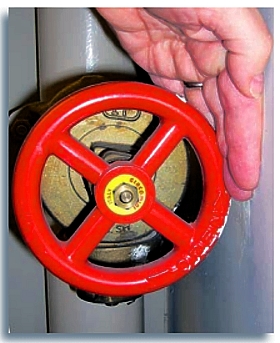No. FP-2013-23 June 4, 2013
Learning Objective: The student shall be able to state the minimum clearance requirements between a standpipe hose connection and nearby obstructions.
 |
The proximity to the wall of this Class III
standpipe hose connection prevents easy
access to open or close the valve.
|
When firefighters are making a coordinated attack on a fire, they want to avoid as many impediments as possible. In mid- or high-rise buildings, standpipe systems are installed to assist firefighters so they do not have to drag hoses up multiple flights of stairs while they prepare to suppress the fire.
An inspector can make life easier for the firefighters by checking even the smallest details on fire protection systems. In the illustration, someone forgot to check the clearance between the Class III standpipe hose connection and the adjacent wall. (See Coffee Break Training FP-2006-41 for an explanation of standpipe “classes.”) A firefighter’s hand protected by a glove would not be able to reach between the hand wheel and wall to open or close the valve in a timely manner.
National Fire Protection Association 14, Standard for the Installation of Standpipes and
Hose Systems, provides guidance on the placement and clearances required for standpipe hose connections. These dimensions are intended to make access to and use of the standpipe system easier for firefighters.
According to NFPA 14:
- — Hose connections and hose stations should be unobstructed and located not less than 3 feet (0.9 meter) or more than 5 feet (1.5 m) above the floor measured from the floor to the center of the hose station valve. This provides easy access to the hose station so firefighters do not have to overly stretch or bend to attach the hose and operate the outlet.
- — Hose connections should be located so there is at least 3 inches (76.2 millimeters) of clearance between any adjacent object and the handle of the valve when the valve is in any position ranging from fully open to fully closed. Although this requirement does not pertain to hose valves located in closets and cabinets, inspectors should verify there is adequate clearance in them as well. The illustration is an example where this dimension was not met.
- — The hose connection should not be obstructed by any closed or open stairwell door(s) or other objects on the landing. This means that early identification of potential placement problems (such as during fire protection system plan review) can go a long way to avoiding the improper placement of standpipe hose stations.
Firefighters attacking a fire have plenty of challenges to overcome to accomplish their objective: fighting a fire protection system should not be one of them.
For additional information refer to NFPA 14, Standard for the Installation of Standpipes and Hose Systems.
Original Sorce NFPA USFA - http://www.usfa.fema.gov/downloads/pdf/coffee-break/cb_fp_2013_23.pdf
---------------------------------------------
Thank you so much for sharing on this valuable information with us for sure your idea is more useful for me.
ReplyDeleteLas Vegas Fire Extinguishers